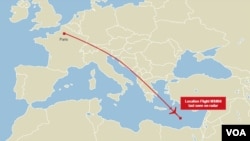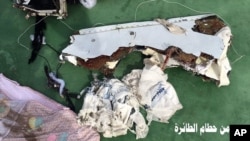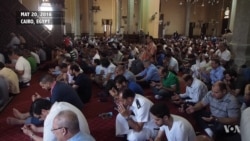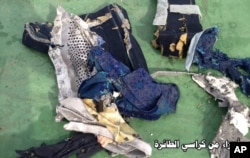Minutes before EgyptAir Flight 804 plunged into the Mediterranean Sea with 66 people on board, smoke was detected inside the plane, investigators said Saturday.
Egypt's military released pictures of wreckage, including a pink bag, a life vest, shredded seat covers and mangled debris showing the EgyptAir name.
The latest information offers clues but no answers to what might have happened, while search crews continued scouring for further wreckage.
The flight recorders, the so-called black boxes, still need to be recovered from the bottom of the Mediterranean, believed to be some 290 kilometers north of Alexandria, before investigators would be able to put together a plausible scenario.
French Foreign Minister Jean-Marc Ayrault said he and other officials, as well as the Egyptian ambassador to France, had met with about 100 family members to express “our profound compassion” over the crash.
Speaking to reporters after the meeting, Ayrault said that “all the hypotheses are being examined, none are being favored.”
The French-made Airbus A320 had been flying from Paris to Cairo early Thursday, when it turned sharply twice before plunging about 6,700 meters and vanishing from radar screens without its crew sending a distress signal.
Egypt, France, Greece and the U.S. are among nations deploying planes and naval vessels to search for the plane.
No militant group has claimed to have carried out an attack.
Egypt's aviation minister, Sherif Fathy, has said a terrorist attack is a more likely cause for the crash than technical failure. But no clear evidence has emerged as to what brought down the plane. No militant group has claimed to have carried out an attack.
The European Space Agency (ESA) said Friday one of its orbiting spacecraft spotted what could be an oil slick 40 kilometers southeast of the plane's last known position and the information had been passed on to relevant authorities conducting a search mission. The agency released a grainy photograph of the scene, which showed little detail and cautioned there was no certainty the slick was from the aircraft.
ESA said a second satellite would pass the area where the slick was found on Sunday.
The agency released a grainy photograph of the scene that showed little detail and cautioned there was no certainty the slick was from the aircraft.
The ESA said a second satellite would on Sunday pass the area where the slick was found.
Three French investigators and a technical expert from the A320's manufacturer, Airbus, arrived Friday in Cairo to aid in the investigation.
U.S. Secretary of State John Kerry offered Egypt continued support for the search.
Kerry offered condolences to Egyptian Foreign Minister Sameh Shoukry for the lives lost on the flight, and said the United States would stay in close contact as the investigation progressed.
Egypt, France, Greece and the U.S. are among nations deploying planes and naval vessels to search for the plane.
WATCH: Prayers for EgyptAir crash victims
Prayers and a symbolic funeral for the passengers were held Friday at Cairo's Sultan Hussein Mosque.
EgyptAir sent interpreters and doctors to the Cairo airport to meet with the passengers' families.
The disappearance has renewed security concerns months after a Russian passenger plane was shot down over the Sinai Peninsula.
The Russian aircraft crashed in Sinai on October 31, killing all 224 people on board. Moscow said it was brought down by an explosive device, and a local branch of the extremist Islamic State group claimed responsibility for planting it.















